
Travel mania/Shutterstock
When Is the Best Time to Visit Japan?
The best time to visit Japan is during the shoulder seasons of April to May and September to November. During these months, the weather is generally mild and sunny across most of the islands, with fewer crowds and lower prices than during the peak summer season, which is also the typhoon season.
Here are some of the benefits of visiting Japan during the shoulder seasons:
- Mild weather: Japan has a temperate climate, but the shoulder seasons offer mild and pleasant temperatures across most of the country. This makes it ideal for sightseeing, exploring, and enjoying the outdoors.
- Smaller crowds: The shoulder seasons are less crowded than the peak summer season, so you’ll be able to enjoy Japan’s popular tourist attractions without having to deal with large crowds. This is especially important if you’re visiting popular destinations like Tokyo, Kyoto, and Osaka.
- Lower prices: Prices for flights, accommodation, and activities are generally lower during the shoulder seasons than during the peak summer season. This means you can save money on your trip without having to sacrifice quality.
Here are some specific examples of how you can enjoy the most of Japan during the shoulder seasons:
- April to May: The weather in April to May is typically sunny and warm, with occasional showers. This is a great time to visit for seeing the cherry blossoms in bloom, visiting temples and shrines, and enjoying outdoor activities like hiking and biking.
- September to November: The weather in September to November is also typically sunny and warm, with occasional showers. This is a great time to visit for seeing the autumn leaves in bloom, visiting hot springs, and enjoying festivals like the Gion Matsuri in Kyoto.
While there are many great times to visit Japan, if you’re looking for the best weather and the most opportunities to enjoy the country’s natural beauty and cultural attractions, then we recommend visiting during the shoulder seasons.
 Average Temperatures by Month
Average Temperatures by Month
|
Jan |
Feb |
Mar |
Apr |
May |
Jun |
Jul |
Aug |
Sep |
Oct |
Nov |
Dec |
| Fahrenheit |
46°
|
48°
|
54°
|
63°
|
71°
|
76°
|
83°
|
85°
|
78°
|
69°
|
60°
|
51°
|
| Celsius |
8°
|
9°
|
12°
|
17°
|
22°
|
24°
|
29°
|
29°
|
26°
|
20°
|
15°
|
11°
|
Climate in Japan
Summer Season in Japan
Japanese summers are hot and humid, particularly in the central and southern regions. This season is characterized by high temperatures and high humidity, making it feel even warmer. Summer is also the time for vibrant festivals and fireworks across the country. In the northern regions, such as Hokkaido, the climate is more temperate and less humid, making it a popular summer retreat.
Rainy Season in Japan
The rainy season, known as 'tsuyu', typically occurs before the start of the actual summer. It brings frequent rain and overcast days, predominantly in the central and southern parts of Japan. The intensity and duration of the rainy season can vary, but it's known for its hydrangeas and lush greenery. Hokkaido and the far north of Honshu usually have minimal impact from this season.
Winter Season in Japan
Winters in Japan are cold, with snowfall common in the northern and mountainous regions, making it a popular destination for winter sports enthusiasts. The central and southern regions experience milder winters, but temperatures can still drop significantly. Winter is also the season for enjoying traditional onsen (hot springs) and winter festivals, such as the famous Sapporo Snow Festival in Hokkaido.
Our Recommendations
| Destination |
Jan |
Feb |
Mar |
Apr |
May |
Jun |
Jul |
Aug |
Sep |
Oct |
Nov |
Dec |
| Japan |
 |
 |
 |
 |
 |
 |
 |
 |
 |
 |
 |
 |






